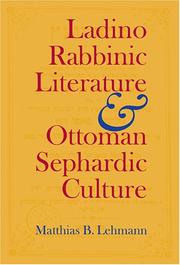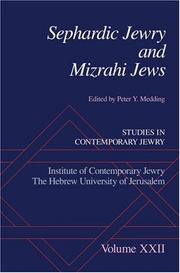| Listing 1 - 10 of 53 | << page >> |
Sort by
|
Book
ISBN: 0804781710 9780804781718 9780804777469 0804777462 Year: 2012 Publisher: Stanford, Calif. : Stanford University Press,
Abstract | Keywords | Export | Availability | Bookmark
 Loading...
Loading...Choose an application
- Reference Manager
- EndNote
- RefWorks (Direct export to RefWorks)
In this book, Sephardism is defined not as an expression of Sephardic identity but as a politicized literary metaphor. Since the nineteenth century, this metaphor has occurred with extraordinary frequency in works by authors from a variety of ethnicities, religions, and nationalities in Europe, the Americas, North Africa, Israel, and even India. Sephardism asks why Gentile and Jewish writers and cultural figures have chosen to draw upon the medieval Sephardic experience to express their concerns about dissidents and minorities in modern nations? To what extent does their us
Jews, Spanish, in literature. --- Literature, Modern - History and criticism. --- Literature, Modern -- History and criticism. --- Sephardim in literature. --- Sephardim in literature --- Jews, Spanish, in literature --- Literature, Modern --- Languages & Literatures --- Literature - General --- Modern literature --- Arts, Modern --- History and criticism --- History and criticism.
Book
ISBN: 0804787905 9780804787901 9780804786003 0804786003 Year: 2014 Publisher: Stanford, California : Stanford University Press,
Abstract | Keywords | Export | Availability | Bookmark
 Loading...
Loading...Choose an application
- Reference Manager
- EndNote
- RefWorks (Direct export to RefWorks)
Between 2003 and 2005, French-born North African Jewish (Sephardi) youth in Paris repeatedly told anthropologist Kimberly Arkin that they were not French and could not to imagine a Jewish future in France. Why? This questions fuels Arkin's analysis of the connections and disjunctures between Jews and Muslims, religion and secular Republicanism, race and national community, identity and culture in post-colonial France.
Jews --- Jews, North African --- Nationalism --- Sephardim --- Jews, Sephardic --- Ladinos (Spanish Jews) --- Sefardic Jews --- Sephardi Jews --- Sephardic Jews --- Jews, Portuguese --- Jews, Spanish --- North African Jews --- Identity. --- France --- Ethnic relations.
Book
ISBN: 0804791430 0804771650 0804791910 Year: 2014 Publisher: Stanford, California : Stanford University Press,
Abstract | Keywords | Export | Availability | Bookmark
 Loading...
Loading...Choose an application
- Reference Manager
- EndNote
- RefWorks (Direct export to RefWorks)
This ground-breaking documentary history contains over 150 primary sources originally written in 15 languages by or about Sephardi Jews-descendants of Jews who fled medieval Spain and Portugal settling in the western portions of the Ottoman Empire, including the Balkans, Anatolia, and Palestine. Reflecting Sephardi history in all its diversity, from the courtyard to the courthouse, spheres intimate, political, commercial, familial, and religious, these documents show life within these distinctive Jewish communities as well as between Jews, Muslims, and Christians. Sephardi Lives offer readers a
Sephardim --- Jewish diaspora --- Jews --- History --- Diaspora, Jewish --- Galuth --- Human geography --- Jews, Sephardic --- Ladinos (Spanish Jews) --- Sefardic Jews --- Sephardi Jews --- Sephardic Jews --- Jews, Portuguese --- Jews, Spanish --- Diaspora --- Migrations
Book
ISBN: 9004392483 9004367535 Year: 2019 Publisher: Brill
Abstract | Keywords | Export | Availability | Bookmark
 Loading...
Loading...Choose an application
- Reference Manager
- EndNote
- RefWorks (Direct export to RefWorks)
From the sixteenth century on, hundreds of Portuguese New Christians began to flow to Venice and Livorno in Italy, and to Amsterdam and Hamburg in northwest Europe. In those cities and later in London, Bordeaux, and Bayonne as well, Iberian conversos established their own Jewish communities, openly adhering to Judaism. Despite the features these communities shared with other confessional groups in exile, what set them apart was very significant. In contrast to other European confessional communities, whose religious affiliation was uninterrupted, the Western Sephardic Jews came to Judaism after a separation of generations from the religion of their ancestors. In this edited volume, several experts in the field detail the religious and cultural changes that occurred in the Early Modern Western Sephardic communities.
Jews --- Sephardim --- History --- Europe, Western --- Ethnic relations --- Jews, Sephardic --- Ladinos (Spanish Jews) --- Sefardic Jews --- Sephardi Jews --- Sephardic Jews --- Jews, Portuguese --- Jews, Spanish --- Hebrews --- Israelites --- Jewish people --- Jewry --- Judaic people --- Judaists --- Ethnology --- Religious adherents --- Semites --- Judaism --- West Europe --- Western Europe

ISBN: 1282072625 9786612072628 0253111625 9780253111623 0253346304 9780253346308 9781282072626 6612072628 Year: 2005 Publisher: Bloomington : Indiana University Press,
Abstract | Keywords | Export | Availability | Bookmark
 Loading...
Loading...Choose an application
- Reference Manager
- EndNote
- RefWorks (Direct export to RefWorks)
In this pathbreaking book, Matthias B. Lehmann explores Ottoman Sephardic culture in an era of change through a close study of popularized rabbinic texts written in Ladino, the vernacular language of the Ottoman Jews. This vernacular literature, standing at the crossroads of rabbinic elite and popular cultures and of Hebrew and Ladino discourses, sheds valuable light on the modernization of Sephardic Jewry in the Eastern Mediterranean in the 19th century. By helping to form a Ladino reading public and
Sephardim --- Ethics in rabbinical literature. --- Ladino literature --- Rabbinical literature --- Hebrew literature --- Jewish literature --- Jews, Sephardic --- Ladinos (Spanish Jews) --- Sefardic Jews --- Sephardi Jews --- Sephardic Jews --- Jews --- Jews, Portuguese --- Jews, Spanish --- Social conditions --- History and criticism. --- Intellectual life
Book
ISBN: 0815651651 9780815651659 9780815632726 081563272X Year: 2012 Publisher: Syracuse, N.Y. : Syracuse University Press,
Abstract | Keywords | Export | Availability | Bookmark
 Loading...
Loading...Choose an application
- Reference Manager
- EndNote
- RefWorks (Direct export to RefWorks)
Offers a wide overview of the Sephardic presence in North and South America through eleven essays discussing culture, history, literature, language, religion and music.
Jews --- Sephardim --- Hebrews --- Israelites --- Jewish people --- Jewry --- Judaic people --- Judaists --- Ethnology --- Religious adherents --- Semites --- Judaism --- Jews, Sephardic --- Ladinos (Spanish Jews) --- Sefardic Jews --- Sephardi Jews --- Sephardic Jews --- Jews, Portuguese --- Jews, Spanish --- America --- Americas --- New World --- Western Hemisphere --- Ethnic relations.
Book
ISBN: 9780804791434 9780804771658 9780804791915 0804791910 0804771650 0804791430 Year: 2014 Publisher: Stanford, California : Stanford University Press,
Abstract | Keywords | Export | Availability | Bookmark
 Loading...
Loading...Choose an application
- Reference Manager
- EndNote
- RefWorks (Direct export to RefWorks)
This ground-breaking documentary history contains over 150 primary sources originally written in 15 languages by or about Sephardi Jews-descendants of Jews who fled medieval Spain and Portugal settling in the western portions of the Ottoman Empire, including the Balkans, Anatolia, and Palestine. Reflecting Sephardi history in all its diversity, from the courtyard to the courthouse, spheres intimate, political, commercial, familial, and religious, these documents show life within these distinctive Jewish communities as well as between Jews, Muslims, and Christians. Sephardi Lives offer readers a
Sephardim --- Jewish diaspora --- Jews --- Diaspora, Jewish --- Galuth --- Human geography --- Jews, Sephardic --- Ladinos (Spanish Jews) --- Sefardic Jews --- Sephardi Jews --- Sephardic Jews --- Jews, Portuguese --- Jews, Spanish --- History --- Diaspora --- Migrations --- Jewish religion --- anno 1800-1999 --- anno 1700-1799

ISBN: 1280424338 9786610424337 0803242840 9780803242845 9781280424335 0803292783 9780803292789 Year: 2001 Publisher: Lincoln, NE : University of Nebraska Press,
Abstract | Keywords | Export | Availability | Bookmark
 Loading...
Loading...Choose an application
- Reference Manager
- EndNote
- RefWorks (Direct export to RefWorks)
Jews --- Sephardim --- Jewish authors. --- Jewish literature --- Authors --- Jews, Sephardic --- Ladinos (Spanish Jews) --- Sefardic Jews --- Sephardi Jews --- Sephardic Jews --- Jews, Portuguese --- Jews, Spanish --- Hebrews --- Israelites --- Jewish people --- Jewry --- Judaic people --- Judaists --- Ethnology --- Religious adherents --- Semites --- Judaism --- Intellectual life --- History and criticism.

ISBN: 9780199712502 0199712506 9786611529338 6611529330 9780195340976 0195340973 1281529338 9781281529336 0190450878 Year: 2007 Publisher: Oxford ; New York : Published for the Institute by Oxford University Press,
Abstract | Keywords | Export | Availability | Bookmark
 Loading...
Loading...Choose an application
- Reference Manager
- EndNote
- RefWorks (Direct export to RefWorks)
Symposium: Sephardic Jewry and Mizrahi Jews. ""Sephardic and Oriental"" Jews in Israel and Western Countries, Sergio Della Pergola (Hebrew University). Jews of Muslim Lands in the Modern Period, Michel Abitbol (Hebrew University). The Brief Career of Prosper Cohen, Yaron Tsur (Tel Aviv University). From Arab Diaspora to Eretz Israel, Doli Benhabib (Open University of Israel). The Sephardic Halakhic Tradition in the 20th Century, Zvi Zohar (Bar-Ilan University). ""Zikui Harabim"", Nissim Leon (Bar-Ilan University). Studying Haredi Mizrahim in Israel, Kimmy Caplan (Bar-llan University). Breaking
Sephardim --- Jewish women in literature --- Women immigrants in literature --- Women, Jewish, in literature --- Jews, Sephardic --- Ladinos (Spanish Jews) --- Sefardic Jews --- Sephardi Jews --- Sephardic Jews --- Jews --- Jews, Portuguese --- Jews, Spanish --- Political activity --- Religious life
Book
ISBN: 1503613224 1503613208 1503613216 9781503613225 9781503613201 9781503613218 Year: 2020 Publisher: Stanford, California : Stanford University Press,
Abstract | Keywords | Export | Availability | Bookmark
 Loading...
Loading...Choose an application
- Reference Manager
- EndNote
- RefWorks (Direct export to RefWorks)
Forging Ties, Forging Passports is a history of migration and nation-building from the vantage point of those who lived between states. Devi Mays traces the histories of Ottoman Sephardi Jews who emigrated to the Americas—and especially to Mexico—in the late nineteenth and early twentieth centuries, and the complex relationships they maintained to legal documentation as they migrated and settled into new homes. Mays considers the shifting notions of belonging, nationality, and citizenship through the stories of individual women, men, and families who navigated these transitions in their everyday lives, as well as through the paperwork they carried. In the aftermath of World War I and the Mexican Revolution, migrants traversed new layers of bureaucracy and authority amid shifting political regimes as they crossed and were crossed by borders. Ottoman Sephardi migrants in Mexico resisted unequivocal classification as either Ottoman expatriates or Mexicans through their links to the Sephardi diaspora in formerly Ottoman lands, France, Cuba, and the United States. By making use of commercial and familial networks, these Sephardi migrants maintained a geographic and social mobility that challenged the physical borders of the state and the conceptual boundaries of the nation.
Sephardim --- Jews, Turkish --- History --- Turkish Jews --- Jews, Sephardic --- Ladinos (Spanish Jews) --- Sefardic Jews --- Sephardi Jews --- Sephardic Jews --- Jews --- Jews, Portuguese --- Jews, Spanish --- Citizenship. --- Diaspora. --- Mexico. --- Migration. --- Networks. --- Ottoman Empire. --- Passports. --- Sephardi. --- Transnational. --- Turkey. --- Mexico --- Politics and government
| Listing 1 - 10 of 53 | << page >> |
Sort by
|

 Search
Search Feedback
Feedback About UniCat
About UniCat  Help
Help News
News